 W
WThe ashy flowerpecker is a species of bird in the family Dicaeidae. It is endemic to Indonesia where it occurs on Seram, Ambon and nearby islands. Its natural habitats are subtropical or tropical moist lowland forest and subtropical or tropical moist montane forest.
 W
WThe Bekisar, or Ayam Bekisar, is the first generation hybrid offspring of the green junglefowl and domesticated red junglefowl from Java. The roosters have a glossy blackish green plumage and are highly prized for their loud clear calls and striking colouration, while the hens are usually dull and infertile.
 W
WThe besra, also called the besra sparrowhawk, is a bird of prey in the family Accipitridae.
 W
WThe dwarf cassowary, also known as Bennett's cassowary, little cassowary, mountain cassowary or mooruk, is the smallest of the three species of cassowaries.
 W
WThe northern cassowary also known as the one-wattled cassowary, single-wattled cassowary, or golden-necked cassowary, is a large, stocky flightless bird of northern New Guinea. It is one of the three living species of cassowary, alongside the dwarf cassowary and the southern cassowary. It is a member of the superorder Paleognathae.
 W
WThe crested partridge also known as the crested wood partridge, roul-roul, red-crowned wood partridge, green wood quail or green wood partridge is a gamebird in the pheasant family Phasianidae of the order Galliformes, gallinaceous birds. It is the only member of the genus Rollulus.
 W
WThe ruddy cuckoo-dove is a species of bird in the family Columbidae. It is a medium-sized, reddish brown cuckoo-dove, found in Brunei, Indonesia, and Malaysia. It is rated as a species of least concern on the International Union for Conservation of Nature Red List of Endangered Species.
 W
WThe elegant pitta is a species of passerine bird in the pitta family Pittidae. It is endemic to Indonesia, where it is found in the Lesser Sunda Islands and Moluccas.
 W
WThe indigo flycatcher is a species of bird in the Old World flycatcher family Muscicapidae. It is found in Indonesia and Malaysia, where it is found in Sumatra, Java and northern montane areas of Borneo. Its natural habitat is tropical moist submontane montane forests between 900m to 3000m, where it is a common to fairly common species.
 W
WThe magpie goose is the sole living representative species of the family Anseranatidae. This common waterbird is found in northern Australia and southern New Guinea. As the species is prone to wandering, especially when not breeding, it is sometimes recorded outside its core range. The species was once also widespread in southern Australia, but disappeared from there largely due to the drainage of the wetlands where the birds once bred. Due to their importance to the local aboriginals as a seasonal food source, as subjects of recreational hunting, and as a tourist attraction, their expansive and stable presence in northern Australia has been "ensured protective management".
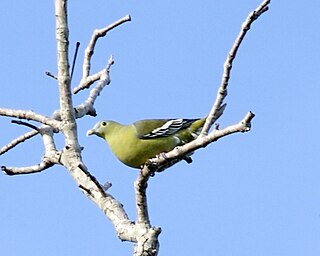 W
WThe grey-cheeked green pigeon is a species of bird in the family Columbidae. It is endemic to Indonesia.
 W
WThe white-necked heron or Pacific heron is a species of heron that is found on most of the Australian continent wherever freshwater habitats exist. It is also found in parts of Indonesia, New Guinea and New Zealand, but is uncommon in Tasmania. The populations of this species in Australia are known to be nomadic like most water birds in Australia, moving from one water source to another often entering habitats they have not previously occupied, taking advantage of flooding and heavy rain where the surplus of food allows them to breed and raise their young. Population explosions have been known when the environmental conditions are right for this species in places where they have been rare or unknown.
 W
WThe comb-crested jacana, also known as the lotusbird or lilytrotter, is the only species of jacana in the genus Irediparra. Like other jacana species, it is adapted to the floating vegetation of tropical freshwater wetlands.
 W
WThe Australian magpie is a medium-sized black and white passerine bird native to Australia and southern New Guinea. Although once considered to be three separate species, it is now considered to be one, with nine recognised subspecies. A member of the Artamidae, the Australian magpie is placed in its own genus Gymnorhina and is most closely related to the black butcherbird. It is not, however, closely related to the European magpie, which is a corvid.
 W
WThe milky stork is a medium, almost completely white plumaged stork species found predominantly in coastal mangroves in parts of Southeast Asia.
 W
WThe Obi paradise-crow is a species of paradise-crow in the family Paradiseaidae along with the birds-of-paradise. This bird was split from its congener, the Halmahera paradise-crow in 2016. The species was first described and named by Heinrich Agathon Bernstein in 1865.
 W
WSharpe's rail is a species of bird in the family Rallidae. It is known only from the type specimen of unknown origin, but it has been speculated that it originated from Indonesia. Due to the lack of recent records, it has been considered extinct, but new evidence suggests it is possibly better regarded as a morph of the buff-banded rail.
 W
WThe scarlet-headed flowerpecker is a species of bird in the family Dicaeidae. It is endemic to Indonesia.
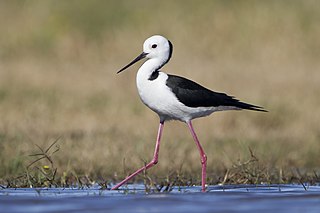 W
WThe pied stilt, also known as the white-headed stilt, is a shorebird in the family Recurvirostridae. It is widely distributed with a large total population size and apparently stable population trend, occurring in Malaysia, Japan, the Philippines, Brunei, Christmas Island, Indonesia, Palau, Papua New Guinea, Australia, and New Zealand. It is listed as Least Concern on the IUCN Red List. It is sometimes considered a subspecies of the black-winged stilt.
 W
WSultan's cuckoo-dove is a dove in the genus Macropygia found in the northern Moluccas, Sulawesi to New Guinea and the western Papuan islands. It was one of three new species defined when the slender-billed cuckoo-dove was split up in 2016.
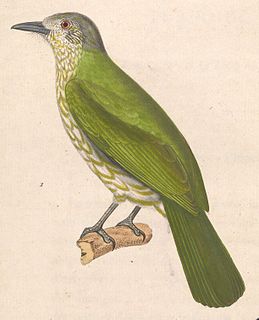 W
WThe Sunda bulbul is a songbird species in the bulbul family. It is the type species of the genus Ixos. It is endemic to Indonesia where it occurs on Sumatra and Java in its natural habitat of subtropical or tropical moist montane forests. It is not considered a threatened species by the IUCN.
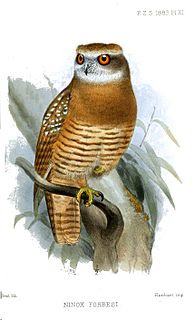 W
WThe Tanimbar boobook, or Tanimbar hawk-owl, is a species of owl in the family Strigidae. It is found in the Tanimbar Islands of Indonesia. Its natural habitat is subtropical or tropical moist lowland forests. It is threatened by habitat loss. It used to be considered a subspecies of the Moluccan boobook.
 W
WThe Sunda teal, also known as the Bebek cokelat or Itik benjut, is a dabbling duck found in open wetlands in Indonesia. The species formerly included the Andaman teal Anas albogularis and the grey teal, Anas gracilis as subspecies, but is currently considered monotypic.
 W
WThe lesser crested tern is a tern in the family, Laridae.
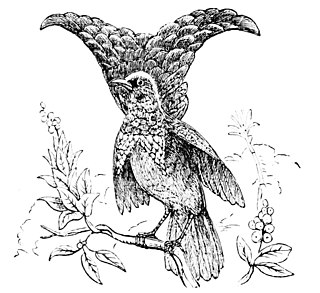 W
WThe Vogelkop superb bird-of-paradise or crescent-caped lophorina, sometimes noted as the curl-caped bird-of-paradise, is a species of the Paradisaeidae (bird-of-paradise) family. It is endemic to the Bird's Head Peninsula in New Guinea. First described in 1930 by Ernst Mayr, it had been treated as a subspecies of the superb bird-of-paradise but was elevated to the status of a full species in 2018 based on its striking black plumage that its feathers absorb 99.95 percent of light and behavioral differences especially visible in the courting male, as shown in audiovisual data documented by Scholes and Timothy Laman of Harvard University's Museum of Comparative Zoology.
 W
WThe Sunda warbler is a species of Old World warbler in the family Phylloscopidae. It is found only in Indonesia.